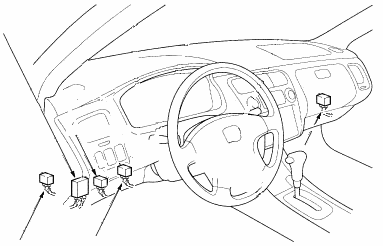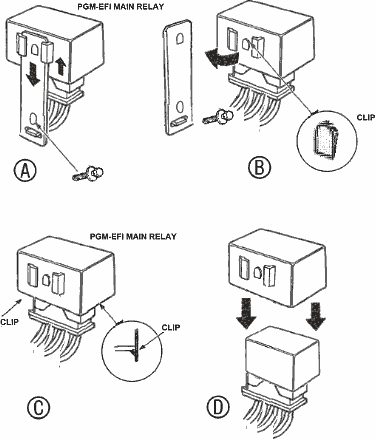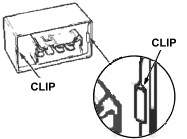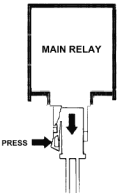|
|
|
|||||||||||||||||||||||||||||||||||||||||||||||||||||||||||||||||||||||||||||||||||||
Main Relay FAQs
What is the main relay?
How does the main relay fail?
How do I know if the main relay is dead?
What are the symptoms?
see home page
How does a good main relay sound like?
What does it look like?
There's no spark. Is it because of the main relay?
How much does it cost?
I can't find my main relay, where is it at?
How does it work?
How do I get the main relay out?
I don't know how to solder and I need it fixed so I can drive around town.
My car stalls, but starts only after five
minutes when the fuel pump whirls, is this the main relay?
My car is not fuel injected and I don't hear the fuel pump but the fuel relay fuse is fine, why won't it start?
How do I check for fuel pressure without a pressure gauge?
How do I check if my fuel injectors are working?
How do I check if my fuel pressure regulator (FPR) is working?
My check engine light or transmission shift light is on
what do I do?
My fuel pump is dead, there is no sound when I turn the
key?
What is the main relay?
The main relay (which consists of two relays that are remotely operated as a switch) is a device that opens or closes the fuel system (and with most models, the ignition system as well) under control of another device usually by the ignition switch or the ECU. The common problem with the main relay is that the car cranks but won't start when the car interior gets hot. During operation the main relay closes the fuel injectors and the ECU, then closes the fuel pump in that sequence. Basically, the main relay is the ECU/Injectors/fuel pump relay with a polarity protection (in case you reverse your battery cables.)
How do I know if my main relay is dead?
|
If you bang on the dashboard and the car starts, chances are that the main relay is the problem. Continue below for more troubleshooting.
|
|
|
|||||||
|
|
|
|
|||||
|
|
Car Won't Start |
|
Main relay troubleshooting for most Honda/Acura PGM-FI relay and harness |
|
|||
|
|
|
||||||
|
|
|
||||||
|
|
|
||||||
|
|
|
|
|||||
|
|
|
|
|||||
|
|
Turn the ignition switch to ON. |
|
|
||||
|
|
|||||||
|
|
|
||||||
|
|
|
||||||
|
|
|
|
|||||
|
|
|
|
|||||
|
|
Does the check engine light go on then off? |
|
|
The ignition switch, ECU, fuse or main relay is faulty. |
|
|
|
|
|
|
||||||
|
|
|
||||||
|
|
|
||||||
|
|
|
|
|||||
|
|
|
|
|||||
|
|
Is there a relay click when the check engine light is on? |
|
|
Main relay is dead. |
|
|
|
|
|
|
||||||
|
|
|
||||||
|
|
|
||||||
|
|
|
|
|||||
|
|
|
|
|||||
|
|
Is there a relay click when the check engine light is off? |
|
|
Main relay is dead. |
|
|
|
|
|
|
||||||
|
|
|
||||||
|
|
|
||||||
|
|
|
|
|||||
|
|
|
|
|||||
|
|
Does the fuel pump whirl for 2 seconds when the check engine light is on? |
|
|
Fuel pump may be dead. Check the fuel pump. |
|
|
|
|
|
|
||||||
|
|
|
||||||
|
|
|
||||||
|
|
|
|
|||||
|
|
|
|
|||||
|
|
Main relay is OK. Turn ignition off. |
|
|
||||
|
|
|||||||
|
|
|
||||||
|
|
|
||||||
|
|
|
|
|||||
|
|
|
|
|||||
|
|
More troubleshooting can be found at mainrelay#Trbsh3 |
|
|
||||
|
|
|||||||
|
|
|
||||||
|
|
|||||||
Steps:
- Close your window and turn the ignition to ON, not start. You should hear a click under the dash. At this moment the check engine light should come on.
- Listen for the hum of the fuel pump at the rear seat where the fuel tank is located. (You can also listen for the hum at the fuel filler nozzle with the cap removed.)
- 2 seconds later you should hear one last click. At this moment the check engine light and the fuel pump should go out.
- If you bang on the dashboard or the main relay and the car starts then the main relay is most likely dead.
- If the check engine light goes out and at the same time you don't hear a click then the main relay is most likely dead.
- If the fuel pump doesn't run and you hear no click when starting then the main relay is most likely dead.
- If the the clicks don't click then the main relay is most likely dead.
- If you hear only one click then the main relay is most likely dead.
- If the check engine light comes on stays on and you hear no clicks then the main relay is dead.
Continuing from step 3:
- Pause for 2 seconds. Turn the ignition to start you should hear a click. If not then the main relay is most likely dead.
- Turn the ignition off, you should hear a click. If not then the main relay is most likely dead.
- Turn off the ignition and try again.
-
More in debt troubleshooting

TIP: If the fuel pump doesn't whine, avoid the temptation to run the
starter for lengths of time. This is unlikely to succeed as the
fuel supply is not there. Better to just bang on the dash or the main relay
while leaving the the ignition switch on or off. Once the main relay
begins to work the check engine light should go out or the fuel pump should
begin to whirl.
How does a good main relay sound like?
- Turn the ignition to ON = click and fuel pump whirls.
- After two seconds = click and fuel pump stops whirling.
- Turn to start = click
- Release key = click
What does the main relay look like?
Look for the "RELAY ASS'Y. MAIN." Below, the image on the far left is generally for the Honda/Acura made after 1998. The middle main relay is usually for the Acura TL, RL and the Acura Legend. The far right is the basic model which fits most Honda and Acura even though the part numbers are different. Mitsuba makes two version of these which usually have their starter switch terminal displaced from each other.
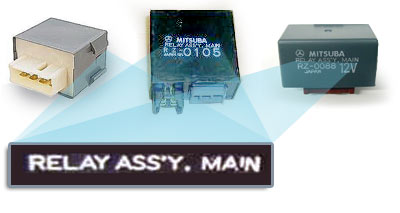
1)
Late model Honda/Acura. 2) Acura Legend and TL, RL. 3) Civic/Accord/CRX/Prelude/Integra.
There's no spark. Is it because of the main relay?
Yes and no.
If your igniter looks like this 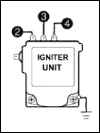 or this,
or this, then yes.
then yes.
If your igniter looks like this, then no. 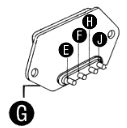
I can't find my main relay, where is it at?
Steps:
- Turn the ignition to ON. You should hear two clicks (coming on at the same time) under the left or right side of the dash board. One click is for the ECU/Injectors the other is for the fuel pump. At this moment the check engine light should come on.
- Listen carefully at the moment the clicks engage (usually somewhere underneath the dashboard.) Reach in and touch the main relay.
- 2 seconds later you should feel or hear only one click if the main relay is at least working or wait until it works. At this moment the check engine light should go out.
- Turn the ignition to start and you should feel or hear a click, turn engine off you should feel or hear another click.
- Most main relays should have seven terminals. Please check if the location is already listed under find it or see flash demo (click on car) for one of the worse location.
How does the main relay fail?
The main relay failure is originally caused by the poor solder application from the factory. The solder joint from the factory on the left is poorly applied. Image 2 shows what happens when the joint does not have enough solder. Due to heat expansion, cold contraction and shock, you will notice a cold solder joint on image #2.
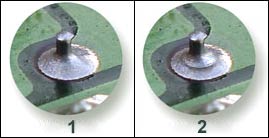
And when the terminals expand, contract and vibrate, it is likely that a layer of hard oxide has built up inside the joint which will lead to a dead main relay. There is nothing wrong with the mechanical functionality of the main relay.
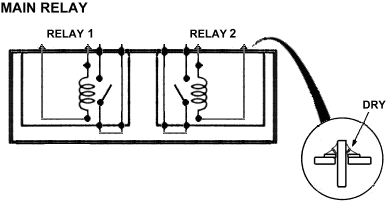
The oxide layers has to be removed by desoldering or otherwise the problem may get worse, leaving you stranded or stalling the vehicle. There is no damage to the main relay if you do decide to delay the repairs.
If you need to delay the repair then you may try a temporary fix under "I don't know how to solder and I need it fixed so I can drive it around town."
How does it work?
When the ignition switch is switched to ON, the fuel injector relay/ECU relay closes. The closing of this relay closes the fuel pump relay in that sequence. If the fuel injector relay fails, so will the fuel pump relay. If the ignition switch isn't switch to start after two seconds the fuel pump shuts off by the computer (ECU) and remains off until the ignition is switch to START. Both relays are inside the main relay.
The components at work consist of 2 relays, 3 diodes and one resistor. The diode prohibits the relay from operating if the battery cables are reversed. The resistor limits the currents to increase reliability.
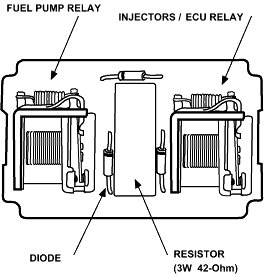
More info
about this subject can be found under
Technical details. ![]()
My car is a carberator (not fuel injected) and I don't hear the fuel pump but the fuel relay fuse is fine, why won't it start?
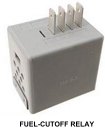 In
such an unlikely event that the coil is partially dead the fuel pump will not run. To
troubleshoot, locate the fuel cut-off relay (an assembly containing solid state devices and not called a main relay on this
unique model) that usually plugs into the under-dash fuse box and run some tests. The exact
location for the second generation Accord is at the bottom left of the fuse box on
the engine firewall side. Push the tab on both ends to release the unit.
In
such an unlikely event that the coil is partially dead the fuel pump will not run. To
troubleshoot, locate the fuel cut-off relay (an assembly containing solid state devices and not called a main relay on this
unique model) that usually plugs into the under-dash fuse box and run some tests. The exact
location for the second generation Accord is at the bottom left of the fuse box on
the engine firewall side. Push the tab on both ends to release the unit.
But since this problem is rare, there won't be any troubleshooting steps here very soon
(which can be too extensive.) The problem can be the fuel cut-off relay, the fuel pump or the
coil.
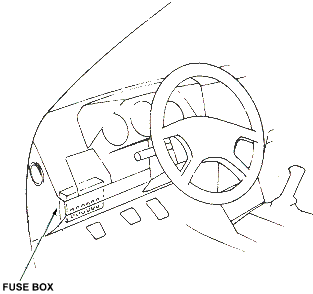
I don't know how to solder and I need it fixed so I can drive my car around town.
There is a temporary solution for you. This method involves your car key. I'll repeat the text found under the solution section:
Open the main relay [image] and press the tip of your ignition key (very firmly) on and around the crack solder joints like this animation [image] on the bad terminals found on the mainrelay joint page. This procedure, if done correctly, allows the main relay to operate normally for up to a month or more. This simply means that solders are pliable (much like a clay) which can be made to overlap and blend onto themselves sufficiently to make a temporary connection. As the oxide forms in the interior of the solder joint, you'll simply ply around the oxide and squeeze a new layer of solder over the other layer of solder on that same joint. The key is to find the offending bad joint, which is nearly impossible under the stress of trying to do all this under a bad lighting conditions. The best you can do is to memorize where the joints usually fail on the mainrelay joint page, which are usually the resistor and the relay coils terminal. Now, if you also coat the solder joint and the PCB board with a conformal coating material you may be able to carry the heat away from the joint and lock the joint from further movements, thereby extending the temporary fix by up to several months.
My car stalls, but starts only after five minutes when the fuel pump whirls, can this be the main relay?
Yes. A severely bad main relay will do this. The joints gets so hot that the joint expands then causes the car to stall and won't start. This could also happen if the joints were not fixed by a professional.
How much does it cost?
20-70USD or more. New used or refurbished.
| Model: | New | Refurbished |
| Mitsuba RZ-0132 or RZ-0159 | 49USD Estimate | 20-30USD |
| Mitsuba RZ-0042 | 49USD Estimate | 20-30USD |
| rz-0105 | 61USD Estimate | 20-30USD |
| Car model | Part number | Relay model |
| 98-02 Honda Accord | 39400-S84-A01 or 39400-S84-003 | RZ-0159* / RZ-0158** |
| 99-04 Odyssey | 39400-S84-A01 or 39400-S84-003 | RZ-0159 / RZ-0158** |
| 03-04 Pilot | 39400-S84-A01 or 39400-S84-003 | RZ-0159 / RZ-0158** |
| 1990-93 INTEGRA | #39400-SH3-003 RELAY | (RZ-0063) |
| 1986-90 LEGEND | #39400-SH3-003 RELAY | (RZ-0063) (RZ-0046) |
| 1991-93 LEGEND | #unknown | (rz-0105) |
| more [image] |
* RZ-0159 is VRM-0022 (e.g., Siemens VRM-0022)
**Aftermarket or an alternative version
How do I check for fuel pressure without a pressure gauge?
Steps: ![]()
- Disconnect the fuel return hose from the fuel pressure regulator.
- Place a fuel proof cup (no picnic cups) under the fuel pressure regulator.
- Turn the ignition switch ON for 2 seconds then turn it off.
- Do step three for five times consecutively or supply direct battery voltage to the fuel pump.
- 230 cc or 7.8oz of fuel should be seen flowing from the fuel pressure regulator. If this is not your "cup of tea," try a second method below.
Steps: ![]()
- Remove a spark plug.
- Put the spark plug onto the spark plug wire.
- Lay the metal part of the spark plug onto a suitable ground (e.g. a bolt, steel tabs.)
- Crank the motor. You should smell or see a mist of fuel coming from the cylinder using a flash light if the fuel injectors are operating.
- Caution: It is dangerous to check for fuel pressure by releasing the fuel filter bleed bolt since it's unpredictable as to how much fuel pressure is retained and which direction the fuel will spray. Do not smoke or work on an overly heated engine.
How do I check if my fuel injectors are working?
Steps:
- With your ears very close to the injectors, and if your lucky, you can hear the injectors clicking while another person cranks the engine. The proper way to is to use a test light or a mechanics stethoscope.
- With a test light, connect one end of the test light to the positive battery terminal.
- Probe each terminal on the back of the injector connector (try one terminal at a time.) Crank the motor and you should see the test light blink. If it blinks the fuel injectors are recieving power and most likely it is working.
- To see if it's spraying fuel, see the method that checks for fuel pressure above. That should tell you if your injectors are working.
How do I check if my fuel pressure regulator (FPR) is working?
Steps: ![]()
- (Same steps as before) Disconnect the fuel return hose from the fuel pressure regulator.
- Place a fuel proof cup (no picnic cups.)
- Turn the ignition switch ON for 2 seconds then turn it off.
- Do step three for five times consecutively or supply direct battery voltage to the fuel pump.
- 230 cc or 7.8oz of fuel should be seen flowing from the fuel pressure regulator.
- When vacuum is applied on the fuel pressure regulator fuel flow should increase. If this is not your "cup of tea," try a second method below.
Steps:
- Place a rag over the fuel return line at the bottom of the fuel pressure regulator to prevent damaging the hose.
- With a vise grip, grip the hose (including the rag) to prevent fuel from returning to the fuel tank.
- If the fuel pressure regulator is dead, or stuck open then the fuel pressure (40-45psi)
should be restored and your engine should start.
My check engine light or transmission shift light is on what do I do?
The first thing to do when your check engine light is on is to look up the code. Most Honda or Acura vehicles will allow you to jump a wire to retrieve the code. To find the code see dtc.html. To troubleshoot the transmission see transmission.html.
My fuel pump is dead, there is no sound when I turn the key?
As you turn the ignition key, the battery check light, check engine light and all lights comes on as usual but you hear no whirl sound from the fuel pump. Most likely the fuel pump is dead. Many people have reported to have unreliable fuel pumps, while others have fuel pumps that can last up to 300k miles or more. To replace or troubleshoot the fuel pump try the Acura Legend or Accord fuel pump test/replace page, see content/legendmainrelay.html
How do I get the main relay out?
Steps: See four ways below to remove the main relay. You may have to reach high up and under the dashboard to complete the job with one hand and a flashlight.
Where
can I find the MainRelay?
I can't find my main relay, where is it at?
|
A. Unbolt the bolt using a 10mm socket (picture A) or
Ab. Unclip the clip from the steel tab and slide it apart (picture A) or
B. Separate the steel tab from the plastic case (picture B) with a
large flat screw driver
jam and twist between the plastic case and the tab or
C. Disconnect the negative battery terminal. Unclip two clips I pointed with two arrows (picture C, or below)
with a small flat head screw driver or with a strong thumb and then yank it out (D.)
This is the preferred choice by many. Mechanics prefer choice A and maybe
B.
|
I have it out, now what do I do with it?
To fix it see mainrelay.html. To see how much a new or used one may cost see estimated cost.

